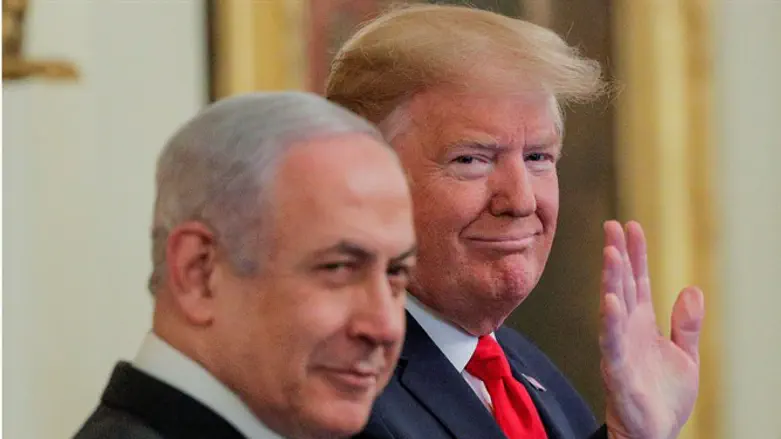
The Trump administration’s Middle East peace plan, officially called “Peace to Prosperity: A Vision to Improve the Lives of the Palestinian and Israeli People” but better known as the “Deal of the Century”, was written off as dead on arrival, even in the early stages of its planning, after President Trump recognized Jerusalem as the capital of Israel.
Hints by senior US officials, including US Ambassador to Israel David Friedman, that the plan would include Israel annexing large swaths of Judea and Samaria, and retaining all Israeli towns in the area, further fueled the view that the administration’s plan would have absolutely no chance of winning over Ramallah, which has in the past rejected far more favorable proposals.
Once the plan was released Tuesday, and it became clear the plan would not only permit Israel to retain all of its towns in Judea and Samaria, but even to annex them in the near future, the spate of protests simmering throughout Palestinian Authority towns much of the day exploded into riots, reflecting the PA’s rejection of the Trump plan.
With Israel retaining roughly 30% of Judea and Samaria and gaining US recognition for its annexation immediately, before any deal is signed with the Palestinian Authority, some have interpreted the Trump plan as a symbolic gesture, one intended to grant Israel its long-desired goal of establishing its eastern border, while making an offer to the PA the Trump administration knows in advance Ramallah will reject.
While on the face of it, this view appears to make sense, a deeper dive into the details of the plan suggest it to be totally erroneous.
What Israel Gets
First, some context is necessary.
Under the Trump plan, referred to by the administration as “The Vision”, Israel does receive far more favorable terms than those offered it in previous final status proposals.
Israel will retain security control over the entire area west of the Jordan River, and the Palestinian state proposed by Trump will be demilitarized – reflecting a long-time Israeli demand.
In addition, the Palestinian Authority must disarm Hamas and completely demilitarize the Gaza Strip – another Israeli demand, and one which is not easily achieved.
Furthermore, the plan requires the PA to end its anti-Israel incitement, as well as its funding of jailed terrorists and the families of terrorists killed during attacks on Israelis.
And with the plan, the US rejects the idea of a Palestinian “right of return” to pre-1967 Israel.
But perhaps most significantly, Israel not only gets to retain all of its towns in Judea and Samaria and annex them, it can do so without actually reaching a deal with the Palestinian Authority.
Some thirty-percent of the land in Judea and Samaria would become part of the State of Israel, compared to less than ten percent in previous US proposals.
What Israel Gives
While the proposal does go farther than previous US peace plans in meeting Israeli needs, both in terms of security and territory, it is far from easy on the Jewish state.
Less publicized are the plan’s requirement that Israel surrender land to a future Palestinian state, if established, in amounts equal to the land it gained through annexation in Judea and Samaria.
Such land swaps are not new to proposed final status agreements, but with greater annexation comes greater land concessions from pre-1967 Israel. The land swaps in the new peace plan would include large Palestinian enclaves in the Negev for industrial zones, farms, and even residential areas. The plan also suggests Israel hand over the Wadi Ara Triangle, a predominantly Arab area in central Israel.
If a final status agreement is reached, Israel will also grant a Palestinian state the right to build a tunnel from the Gaza Strip to Judea, linking Judea – Samaria with Gaza.
In addition, the Palestinian state will have rights to use the Ashdod and Haifa ports, as well as rights to develop the north Dead Sea shore into a resort area – that is, in territory which under the plan is to become sovereign Israeli land. Citizens of the new State of Palestine will have full access to this area, supposedly under Israeli sovereignty.
The Status of Jerusalem
Perhaps the most contentious issue, the future of Jerusalem, was, surprisingly, not clearly addressed in President Trump’s speech Tuesday, even as he discussed its future.
Seemingly contradicting himself, Trump vowed that the city would remain undivided as Israel’s capital – yet in the same address, said a future Palestinian state would have its capital in Jerusalem.
In the plan itself, the Trump administration attempts to square the circle, saying that the city should remain physically undivided – even as it is partitioned into two separate areas – the Israeli Jerusalem, and the Palestinian Al Quds.
How does that work?
Citing Israel’s security barrier, which cuts through the Arab neighborhoods of Shuafat and Kafr Aqab, the plan proposes turning the de facto divide in the city into a de jure one.
Jerusalem will remain the sovereign capital of the State of Israel, and it should remain an undivided city.
The sovereign capital of the State of Palestine should be in the section of East Jerusalem located in all areas east and north of the existing security barrier, including Kafr Aqab, the eastern part of Shuafat and Abu Dis, and could be named Al Quds or another name as determined by the State of Palestine.
While it is true, both Kafr Aqab and Shuafat have shirked Israeli authority for years, the above clause nevertheless constitutes a partition of Jerusalem – and the handing over of areas which have been part of the State of Israel since June 1967 – no small concession by Israel.
Israel would also commit to turning part of Jerusalem – the Jerusalem which remains in Israel hands – into a Muslim tourist center.
The Stick First – Then the Carrot
In its details, the Trump plan can hardly be considered stingy vis-à-vis the Palestinian Authority.
While it does offer Israel nearly a third of Judea and Samaria – much of the area to be annexed being desert in the Judean Desert and Dead Sea areas – it would compensate the PA with territories of equal size in pre-1967 Israel.
And beyond the other concessions it would extract from Israel, if accepted, the plan also offers the cash-strapped PA a massive economic growth package totaling some $50 billion dollars spread over 10 years.
To put that number into perspective, the entire combined gross domestic product of the Palestinian Authority and Gaza Strip is just over $16 billion.
Why is the plan so generous to the Palestinian Authority, if it crosses one of the PA’s red lines before a deal is even reached – allowing Israel to annex much of Judea and Samaria, and even recognizing that annexation?
The answer lies in another term of the proposal
If the Palestinian Authority rejects the deal, which it is widely expected to do, it will have a grace period of four years to change its mind.
During that time, Israel will be barred from establishing new towns outside of the areas to be annexed, or expanding existing towns outside of the area designated for Israel.
Israel will also be required not to carry out demolitions in the area designated for Palestinian statehood during the four year period, outside of certain special instances.
The reasoning behind this is clear: the Trump administration readily understands that the Palestinian Authority’s first reaction – as it has already declared – will be to reject the plan.
But, unlike previous proposals, the Trump plan gives Israel the green-light to annex in Judea and Samaria before a peace deal is reached, and not contingent on an agreement being signed.
In essence, it takes one of the most contentious issues – and one of Israel’s key demands – off the table forever.
Thirty percent of Judea and Samaria will be annexed to Israel and recognized by the US as Israeli territory.
That leaves the PA with one of two options: continue to reject the US plan, and end up with no state, or accept the plan within the four-year period and get 100% of what remains, along with a swath of benefits.
It effectively makes the most difficult choice for the PA in final status talks – and leaves the PA with nowhere to go but up. The territory annexed by Israel becomes a fait accompli, shifting Ramallah’s incentives to favor a deal which will allow them to receive the benefits for what they perceive as their losses in the first portion of the deal.
The move irrevocably takes away the PA’s primary bargaining chips, while simultaneously offering it a pot of gold if it is willing to play ball.
